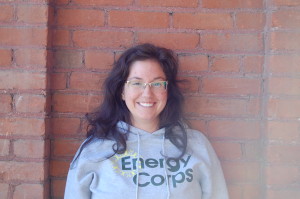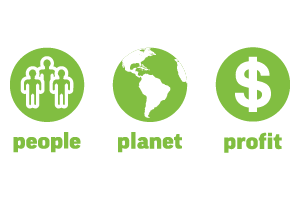PC: https://solect.com/business-beyond-profit-focusing-triple-bottom-line/
By Katelynn Essig
Working in a conservative community to complete energy efficiency and renewable energy projects seems nearly impossible from a distance. This is, in large part, due to the idea and desire to communicate the need to ‘fight climate change’ and reduce ‘carbon emissions’. In school, we are taught these are the most pressing issues and that we must figure out our path to fighting them as we move into our career. But the real world works a lot differently. Unfortunately, the real world doesn’t actually want to hear about those pressing issues of concern, especially in rural Montana. Those who are mediocre to curbing carbon emissions may want to know what the return on investment is going to be but other folks straight up don’t care, at all. This calls for the need to throw out the somber climate change lingo and negotiate in different formats to get the job done.
I was fortunate enough to have a few fabulous people on City Council to bring Energy Corps to the City of Red Lodge but I’m still working for a City that has numerous other vital functions. It’s hard to negotiate the need to install electric vehicle charging stations and have the City pay for their operations when the entire sewer system within City limits needs to be rebuilt. From my perspective, those charging stations are a no brainer but any amount of money that is taking away from more immediate needs becomes a challenge of communication. The really great thing about this dilemma is that us environmental studies nerds already have the tools in our toolbox, aka education, to communicate in a way for people to connect with you and your project. That magic tool is the triple bottom line. A lot of people still new to the idea though would say otherwise. Wouldn’t bringing these three areas into a conversation with a conservatively minded person make it more difficult to communicate a need for an energy efficiency project?
In this field, we’ve become systems thinkers. We’ve studied how all the systems in the world connect in some fashion and how each system needs support for the rest of the systems to work. Typically, we look at the triple bottom line as being a tool to evaluate the performance of a project. For example, looking at a solar installation to see how much energy savings has occurred (economic), what the carbon dioxide savings have been (environmental) and how the operations and maintenance have benefitted the local solar business market (social). This three-tiered thinking has been extremely helpful not just related to specific projects but for running a better business too; one that provides full benefits to all its employees (social), who has invested in energy efficiency practices (environment), and who is investing its money consciously (economic). What I don’t really remember in school is using this method to communicate effectively with ‘the other side’ and even if I did and I don’t remember (which is totally possible), how to do it correctly.
The benefits of speaking in terms of the “triple-bottom line” have become an essential part of my negotiating methods when talking to City employees and Council about my projects. The environmental and economic portions are pretty straightforward but the social sphere has a real opportunity to talk about values. Values are something that no matter who you are, you can generally agree upon. They cross political barriers and leave you with the opportunity to have conversations about potentially polarizing issues without the need to divide. Instead you are actually coming together because most people care about the health and safety of workers. For example, I’ve been working endlessly on an LED building retrofit project. Prior to even looking at the buildings, we were simply looking at this project option to save money and reduce our energy usage. Originally, there didn’t seem to be a social need but as we went around to do our energy audit, it was obvious that some of the garages had terrible lighting. Worse yet, some of our employees were doing mechanical and welding work in the low lighting. Safety became a huge and important part of the conversation. I found this outlet to talk about lighting through the eyes of values to get folks on board and express why this project needed to be done. Now it wasn’t like the cost benefit completely disappeared, it still held its importance but at least I was able to fill in the last circle with some social benefits to really create a full-proof argument of why this project needed to be completed.
Maybe I’m just late to the game on this one but the new perspective that this might actually help when speaking to conservative folks really shows the depth of this simple model. It’s really up to us to connect with people from all walks of life when working on sustainability projects across the board. We really can’t afford to trudge on without them but I think if we dig deep into the triple bottom line, there are ways for us to connect with folks who we probably wouldn’t connect with otherwise. Unfortunately, this is a never-ending task that will probably never go away in my lifetime but we must persist. I think we will.
 Katelynn Essig has a Master’s Degree from the University of Illinois in Sustainable Development and Policy. She’s also worked on Economic Development issues for the City of Oregon City in Oregon while serving in Resource Assistance for Rural Environments AmeriCorps program through the University of Oregon. Katelynn is serving her second term with Energy Corps as the Sustainability Coordinator for the City of Red Lodge. She had big success in her first term by installing 4 electric vehicle charging stations, completing solar analyses, and installing LED lightbulbs in 14 of the City’s streetlights.
Katelynn Essig has a Master’s Degree from the University of Illinois in Sustainable Development and Policy. She’s also worked on Economic Development issues for the City of Oregon City in Oregon while serving in Resource Assistance for Rural Environments AmeriCorps program through the University of Oregon. Katelynn is serving her second term with Energy Corps as the Sustainability Coordinator for the City of Red Lodge. She had big success in her first term by installing 4 electric vehicle charging stations, completing solar analyses, and installing LED lightbulbs in 14 of the City’s streetlights.








